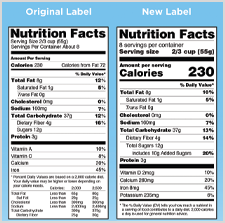Why is the Nutrition Facts Panel Changing?
August 28, 2019
UPDATE November 1, 2019: The Food and Drug Administration (FDA) announced in October 2019 that it will be implementing a grace period for brands that make more than $10 million a year to change their nutrition facts label to comply with the new standards. The deadline is still January 1, 2020, but the FDA will wait 6 months before starting any enforcing actions.
You are familiar with the black and white nutrition facts panel on the back of your favorite products, but what some of you may not know is that it will be getting a new and improved look. Some brands have already started to make the change, but for those of you who haven’t, this is your friendly reminder that the clock is ticking! Back in 2016, the FDA announced that information on the nutrition facts panel will need to be changed.
While that was a few years ago, we wanted to refresh your memory because if your labels aren’t compliant by the deadline, you might receive warning letters from the FDA, or worse yet, have your products pulled from the shelf.
Once January 1st, 2020 comes around companies with $10 million or more in annual food sales need to be following the updated regulations. Companies that have under $10 million in annual food sales have until January 1st, 2021.
Relevance In Consumer’s Eating Habits
The nutrition label hasn’t been changed in over 20 years, but in the last two decades, our diets have. The goal of the new regulation is to provide consumers with nutrition information that is relevant to how we eat in 2019. Did you know that most people don’t get enough potassium and vitamin D? Because of that, the new label will have potassium and vitamin D replacing vitamins A and C.
A new row for added sugars will be included in the label update. If you consume over 10% of your daily calories from added sugars, the likelihood of reaching nutrient needs is difficult. The new added sugar information will be listed in grams in addition to the familiar percentage on the right-hand side.
Realistic Serving Sizes
Do you ever feel restricted to the recommended serving size for ice cream? Well, we’ve got good news for you, the serving size is going from 1/2 to 2/3 of a cup. Instead of telling consumers how much of something they should eat, the new serving sizes are based on how much consumers typically consume. In addition to the adjustment of realistic serving sizes, you will also notice that the font for serving sizes and calories will be larger and more pronounced on the packaging.
The new regulations and formatting make this is a good time to consider a rebrand of your product’s packaging, or a minor adjustment to your existing graphics. Either way, Inland has transition support to help you through any changes you might need. Contact us to let us know how we can help! To view frequently asked questions and more resources regarding the nutrition facts change, click here.



